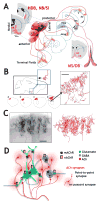Basal Forebrain Cholinergic Circuits and Signaling in Cognition and Cognitive Decline
- PMID: 27657448
- PMCID: PMC5036520
- DOI: 10.1016/j.neuron.2016.09.006
Basal Forebrain Cholinergic Circuits and Signaling in Cognition and Cognitive Decline
Abstract
Recent work continues to place cholinergic circuits at center stage for normal executive and mnemonic functioning and provides compelling evidence that the loss of cholinergic signaling and cognitive decline are inextricably linked. This Review focuses on the last few years of studies on the mechanisms by which cholinergic signaling contributes to circuit activity related to cognition. We attempt to identify areas of controversy, as well as consensus, on what is and is not yet known about how cholinergic signaling in the CNS contributes to normal cognitive processes. In addition, we delineate the findings from recent work on the extent to which dysfunction of cholinergic circuits contributes to cognitive decline associated with neurodegenerative disorders.
Copyright © 2016 Elsevier Inc. All rights reserved.
Figures




References
-
- Aarsland D, Mosimann UP, McKeith IG. Role of cholinesterase inhibitors in Parkinson’s disease and dementia with Lewy bodies. J Geriatr Psychiatry Neurol. 2004;17:164–171. - PubMed
-
- Backus AR, Schoffelen JM, Szebenyi S, Hanslmayr S, Doeller CF. Hippocampal-Prefrontal Theta Oscillations Support Memory Integration. Curr Biol. 2016;26:450–457. - PubMed
-
- Bartus RT, Dean RL, 3rd, Beer B, Lippa AS. The cholinergic hypothesis of geriatric memory dysfunction. Science. 1982;217:408–414. - PubMed
Publication types
MeSH terms
Substances
Grants and funding
LinkOut - more resources
Full Text Sources
Other Literature Sources

